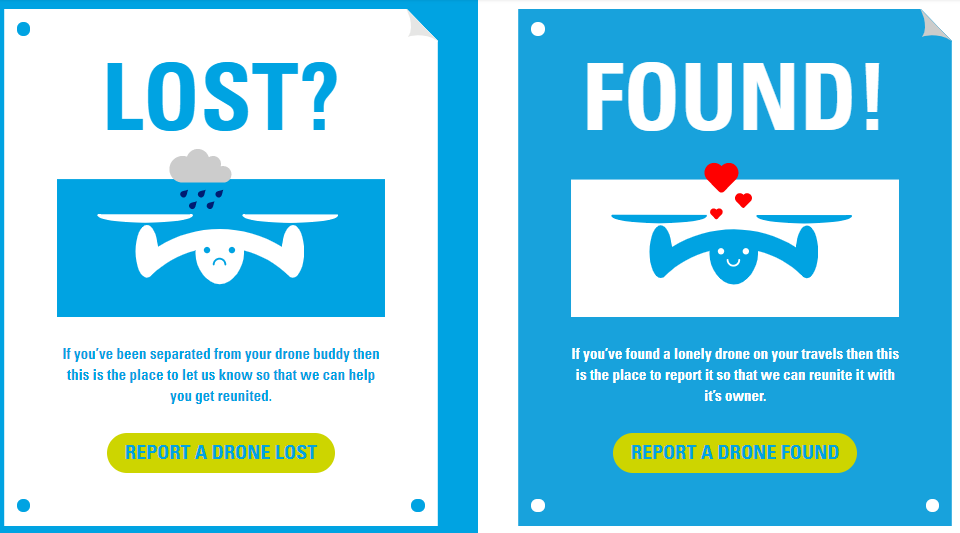With over a quarter of drone owners admitting to having lost their drone, this service at dronesreunited.uk will be able to help reconnect owners with their lost devices thanks to the new UK drone registration system.
Drone registration also goes live today (5/11).
LONDON, 5 November 2019: The UK Civil Aviation Authority (CAA) has today launched Drones Reunited, a platform set up to help recover the thousands of drones lost in the UK each year.
Thanks to the new national drone registration scheme also launched today, Drones Reunited will help drone users recover their missing machines – a serious problem for flyers, as new research reveals that over a quarter of drone owners (26%) have lost a drone.
The study found that drones are most at risk of being lost due to flight malfunctions – with more than half (51%) of misplaced drones going missing due to battery loss, poor signal, or a technology failure. And in a quarter of cases it’s down to pilot error.
Most worryingly for drone owners, when a drone is lost there is no clear procedure for getting it back.
Drones are expensive – costing anywhere from £100 to many thousands – and losing them can really hit owners in the pocket, with many unable to replace their gadget. This means demand for the Drones Reunited service is already high, with the study finding that UK drone owners would be willing to pay on average £59.30 to retrieve a lost drone.
This amount rises to over £150 for a drone worth more than £500.
Access to the Drones Reunited platform is free as part of drone registration – a mandatory scheme for all drone owners and operators in the UK having drones over 250g. Registration costs just £9 – a fraction of the price users would be willing to pay to recover their lost devices.
Indeed, the drone registration scheme is critical to the launch of Drones Reunited. With each registered operator having a unique code that they must apply to their drones we can use this number to, for the first time, introduce the reunited service. To take advantage of the service anyone losing a drone must post their details to the Drones Reunited site, while anyone who finds a drone will be encouraged to check the device for a registration number, reporting this to the platform. The CAA will then be on hand to act to help ensure drones are returned to their rightful owners.
Jonathan Nicholson, Assistant Director of Communications, CAA, said:
“Drones Reunited is a UK-first – an essential service that is only possible thanks to the drone registration scheme that is also launched today. The service is about giving something back to the community, helping responsible drone owners and operators to be reunited with lost drones and continue flying.
“Our aim is for the Drones Reunited platform to become an essential service for the drone community – the first port of call for anyone who has lost, or found, a drone.”
The Drones Reunited platform can be accessed here: dronesreunited.uk
Users can now also register as a drone operator and/or flyer here: register-drones.caa.co.uk
Please note – registration is mandatory for operators of drones over 250g and must be completed by 30th November 2019. Failure to do so leaves drone users at risk of penalties up to £1,000.
As well as registration, anyone flying a drone over 250g must also take an online education and test.
After being made aware of the need to register 44% felt that being able to track and find lost drones was a real benefit of the registration scheme.
Our research also provided extra insight into drone users across the UK – revealing that it is millennials who are most likely to lose their drone: 36% of 18-34-year olds have lost a drone compared to 20% of those aged 35 and above.
However, this is balanced out by the fact that millennials are more likely to insure their drone: 54% of 18-34 year olds have some kind of insurance for their drones compared to only 26% of those aged 35+.
Regionally, you can find the most unfortunate drone owners in Northern Ireland, where 50% of users admit to having lost a drone. Elsewhere, drone flyers in London (37%) and Scotland (33%) are the next most likely to lose their drone.
The most careful users live in the North East, where only 13% of users have lost a drone. The East Midlands and the East of England are also cautious flyers, with only 17% and 18% having seen their drone go astray.



